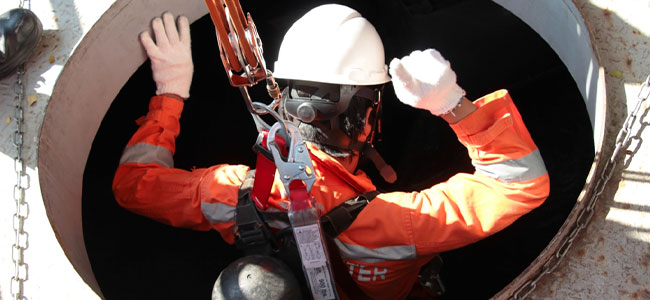Confined spaces are found in many workplaces, from construction sites to industrial plants. They can be dangerous due to their limited access and egress and potential hazards such as toxic atmospheres, limited oxygen, and physical entrapment.
Proper confined space training is crucial in preventing workplace accidents and ensuring workers’ safety. This blog post will explore the importance of space training, the types of hazards present in confined spaces, and how comprehensive training programs can mitigate these risks.
Understanding Confined Spaces
Definition of Confined Spaces
A confined space is defined by three main characteristics:
- Limited openings for entry and exit
- Unfavorable natural ventilation which could lead to dangerous air conditions
- Not intended for continuous worker occupancy
Common examples include storage tanks, silos, vessels, sewers, tunnels, and pits.
Types of Hazards in Confined Spaces
Confined spaces can present numerous hazards that make them dangerous:
- Atmospheric Hazards: These include toxic gases, flammable atmospheres, and oxygen deficiency. For instance, hydrogen sulfide and carbon monoxide are common toxic gases in confined spaces.
- Physical Hazards: These involve risks such as falling objects, moving machinery, or the potential for engulfment by materials like grain or sand.
- Ergonomic Hazards: The limited space can cause strain due to awkward working positions, and restricted movement can lead to musculoskeletal injuries.
- Environmental Hazards: Extreme temperatures, poor lighting, and high noise levels can also pose significant risks.
Importance of Confined Space Training
Legal Requirements
In many jurisdictions, employers are legally required to provide confined space training to employees who may work in or around confined spaces. Regulations often mandate specific procedures for entry, monitoring, and emergency response to ensure worker safety.
Enhancing Worker Awareness
Training programs raise workers’ awareness of the potential hazards associated with confined spaces. Workers learn to identify hazardous conditions and understand the importance of following safety protocols.
Promoting Safety Culture
Confined space training promotes a safety culture within the organization. When workers are knowledgeable about safety procedures and feel confident in their ability to perform tasks safely, they are more likely to take proactive measures to prevent accidents.
Key Components of Confined Space Training
Hazard Identification and Risk Assessment
Training should begin with understanding the types of hazards that may be present in confined spaces. Workers should be trained to conduct thorough risk assessments, including evaluating the atmosphere, identifying physical hazards, and assessing ergonomic risks.
Proper Use of Equipment
Workers need to be familiar with the equipment used in confined spaces, such as gas detectors, ventilation systems, personal protective equipment (PPE), and communication devices. Training should include hands-on practice with this equipment to ensure proficiency.
Entry and Exit Procedures
Safe entry and exit procedures are critical in preventing accidents. Workers should be trained on how to use permits, follow proper entry protocols, and understand the roles of attendants and supervisors. Emphasis should be placed on ensuring that entry and exit points are always accessible and unobstructed.
Emergency Response and Rescue Plans
Even with the best precautions, emergencies can still occur. Training programs must include detailed emergency response plans and rescue procedures. Workers should know how to initiate a rescue, use rescue equipment, and perform first aid if necessary.
Continuous Monitoring and Communication
Continuous monitoring of the confined space environment is essential to detect changes that could pose risks. Training should cover the use of monitoring devices and the importance of maintaining constant communication with team members both inside and outside the confined space.
Case Studies: The Impact of Confined Space Training
Case Study 1: Successful Rescue Operation
In a manufacturing plant, a worker was performing maintenance inside a storage tank when the atmosphere suddenly became toxic due to a chemical leak. Because of their confined space training, the team quickly recognized the danger and followed the emergency response procedures. The worker was safely rescued without injury, highlighting the effectiveness of their training program.
Case Study 2: Preventing a Fatal Incident
At a construction site, workers were required to enter a sewer line to inspect and repair a blockage. Thanks to their confined space training, they conducted a thorough risk assessment and used appropriate ventilation and gas detection equipment. They discovered high levels of methane and hydrogen sulfide, which could have been fatal. The work was postponed until the area was made safe, preventing a potential disaster.
Implementing an Effective Confined Space Training Program
Assessing Training Needs
The first step in implementing a training program is to assess the specific needs of the workplace. This involves identifying the types of confined spaces, the hazards associated with them, and the employees who require training.
Developing a Comprehensive Curriculum
A comprehensive training curriculum should cover all aspects of confined space work, including hazard identification, risk assessment, equipment use, entry and exit procedures, emergency response, and continuous monitoring. The curriculum should be tailored to the specific needs of the workplace.
Hands-On Training and Simulations
Practical, hands-on training is crucial for effective learning. Simulations of real-life scenarios can help workers develop the skills they need to respond to emergencies and perform tasks safely. The training program should include regular drills and practice sessions.
Regular Refresher Courses
Confined space training should not be a one-time event. Regular refresher courses are essential to keep workers up to date with the latest safety practices and to reinforce their skills. This helps to maintain a high level of safety awareness and preparedness.
Evaluation and Continuous Improvement
Training programs should be regularly evaluated to ensure their effectiveness. Feedback from workers, incident reports, and safety audits can provide valuable insights for continuous improvement. Adjustments should be made to the training program as needed to address any gaps or emerging risks.
Conclusion
Confined space training is critical in preventing workplace accidents and ensuring the safety of workers. By understanding the hazards, implementing thorough training programs, and promoting a safety culture, employers can significantly reduce the risks associated with confined spaces. Investing in proper training protects workers and enhances productivity and compliance with legal requirements. Remember, safety in confined spaces starts with comprehensive training and a commitment to continuous improvement.
Keep an eye for more news & updates on TribuneBreaking.Com!







